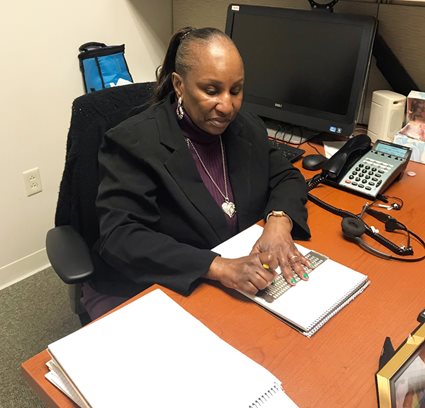World Braille Day
Annually celebrated on January 4th is World Braille Day, which is held in recognition of Louis Braille and his contribution to helping those who are blind and visually impaired to both read and write.
A six-dot fingertip reading system, braille has enlightened the lives of millions of people who have lost their vision.
 One of those people is Virginia “Jinnie” Scott, a social worker and part of the interdisciplinary team at the William Feinbloom Vision Rehabilitation Center, housed at The Eye Institute (TEI) of Salus University’s Oak Lane facility.
One of those people is Virginia “Jinnie” Scott, a social worker and part of the interdisciplinary team at the William Feinbloom Vision Rehabilitation Center, housed at The Eye Institute (TEI) of Salus University’s Oak Lane facility.
At 26-years old, Scott lost her vision from complications of Retinitis Pigmentosa, a rare and often inherited disease that causes the retina to slowly deteriorate. A very traumatizing diagnosis, Scott refused to seek therapeutic treatment for two years -- in hopes that her sight would return.
It didn’t.
“At the time I just thought it was the end of my world,” she said. “I was an avid reader and I thought that it was the cruelest thing to take away my vision, but I survived.”
After coming to terms with her diagnosis, she began to answer calls from social service agents to help get her into the appropriate therapy. That’s when she first learned braille.
She went to a rehabilitation class every day for four months and learned braille basics – known as “grade one braille” before she began learning how to use a typewriter and a computer. After the class ended, her teacher encouraged her to continue working on it, and even gave her a textbook to pull from. Day and night, Scott put all of her energy into learning braille.
 Scott not only learned to embrace braille – but now cherishes it. “Braille is my language,” she said. It opened up a whole new world of keeping notes and phone numbers to name a few tasks. She has again built a library of books – but this time in braille - including a collection of Bibles.
Scott not only learned to embrace braille – but now cherishes it. “Braille is my language,” she said. It opened up a whole new world of keeping notes and phone numbers to name a few tasks. She has again built a library of books – but this time in braille - including a collection of Bibles.
It also helped Scott in her career as a social worker.
For the last 22 years, Scott has been an integral part of the interdisciplinary team at the Feinbloom Rehabilitation Center. As a social worker, she serves as an advocate, referring patients for additional services and resources that may be helpful.
“I love my job,” she said. “I love bringing awareness to people and help them improve their quality of life.”
Using specialized tools such as a screen reader, along with her knowledge of braille, has really helped her to be as equally as independent as she is successful at her job and its day to day functions
When writing braille, Scott uses a writing tablet with guidance from both a slate and a stylus, writing from right to left, and reading it back from left to right. She acknowledges it may be an antique way of doing it, but she still uses this style because it works for her.
Decades after losing her sight, she continues to make it her personal mission to raise awareness and ensure anyone experiencing vision loss receives the services, resources, and care they need to succeed. It’s more than her job; it’s a part of her life.